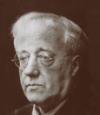In his classic analysis of the Holst First Suite (April 1975 issue), Frederick Fennell urged conductors to "Live with it, learn it any way you can, but know it, and when you come close to knowing it you will know a great deal about a lot of other music as well." On the occasion of the Suite’s 100th anniversary, we have invited a distinguished group of conductors and composers to share their reflections and conducting suggestions for this essential work for band. For many the Suite was an early step toward a life spent in music.
James Barnes
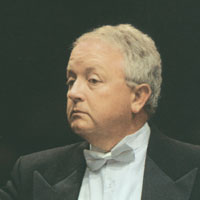 When I was in the ninth grade (1964), I bought the Eastman Wind Ensemble LP British Band Classics. My introduction to Holst’s First Suite in E flat for Military Band was Frederick Fennell’s masterful interpretation of the work, so I suppose my opinion of it started at the top. It is a wonderful piece, but certainly not on the same creative level as Florent Schmitt’s incredibly demanding Dionysiaques, which was composed in 1913 for the Garde Republicaine Band in Paris. The beauty of Holst’s First Suite, however, is that it is simply cast and straightforward but still it retains musical and artistic integrity. Any good high school band can play the work, but it can also be played by the finest professional band without batting an eye. That is wonderful.
When I was in the ninth grade (1964), I bought the Eastman Wind Ensemble LP British Band Classics. My introduction to Holst’s First Suite in E flat for Military Band was Frederick Fennell’s masterful interpretation of the work, so I suppose my opinion of it started at the top. It is a wonderful piece, but certainly not on the same creative level as Florent Schmitt’s incredibly demanding Dionysiaques, which was composed in 1913 for the Garde Republicaine Band in Paris. The beauty of Holst’s First Suite, however, is that it is simply cast and straightforward but still it retains musical and artistic integrity. Any good high school band can play the work, but it can also be played by the finest professional band without batting an eye. That is wonderful.
Having conducted more performances and rehearsals of the First Suite than I can recall, I have a few suggestions about performing the work.
1. The version edited by Colin Matthews is best to use because the 1948 Americanized version is a mess. Use cornets if you have them. The trumpet parts are not essential, and all they do is mess up the cornet lines. Don’t double the alto and tenor saxophone parts, and the baritone saxophone isn’t necessary either.
2. The first movement is not a Chaconne but a passacaglia. The British have always gotten this backwards. A chaconne is a set of variations on a chord progression, as in the last movement of Brahms’s 4th Symphony. A passacaglia, on the other hand, is a set of variations on a ground bass, which precisely describes this movement. It is a set of 15 variations on the opening measures, which are played by tubas and euphoniums. Most conductors take this first movement too rapidly, and I pay more attention to the moderato than the Allegro in the tempo marking. At too fast a tempo the first movement loses majesty and profundity; it runs right over the dark sonorities and takes the drama out of the movement.
3. The Intermezzo is a tiny masterpiece of dancing and joy that is just about as clever as it can be. It is my favorite movement. The way Holst weaves all these different motives together at the end of the movement is remarkable. Play this as lightly as possible and don’t spare the tempo – it truly is a Vivace.
4. Even in the Matthews version, some editing of the opening little march in the “B band” needs some extra dynamics; otherwise, this rather long passage has a rather dull sameness about it. Don’t slow down at letter A as the “Elgar melody” comes into play after the key change. This is done all the time, but it is a poor choice. If Holst wanted it to be slower, he would have indicated it so. Eight measures after D the low woodwinds and low brass should cut beat one short along with the rest of the band or it sounds sloppy. I think this was just an editing oversight on Holst’s part; I cannot imagine his wanting half the band playing through the melodic cutoff.
James Barnes is professor of music and division director of music theory and music composition at the University of Kansas.
Frank Ticheli
T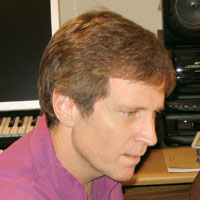 wenty-five years later, my memory still rings from the experience. It was late spring of 1984. I was 26, a graduate student playing trumpet in the University of Michigan Symphony Band under Bob Reynolds. We were on our European tour and had been in Italy for two weeks as performers in La Scala’s production of Stockhausen’s opera Samstag aus Licht (Saturday from Light).
wenty-five years later, my memory still rings from the experience. It was late spring of 1984. I was 26, a graduate student playing trumpet in the University of Michigan Symphony Band under Bob Reynolds. We were on our European tour and had been in Italy for two weeks as performers in La Scala’s production of Stockhausen’s opera Samstag aus Licht (Saturday from Light).
We needed a break, both spiritually and tonally, and off we went to perform a side concert at Florence’s Maggio Musicale. Some Strauss, some Hindemith, and then Bob’s assistant conductor, Larry Rachleff, ascended the podium to conduct Holst’s Suite in E flat – business as usual.
But at the first movement’s climax, something happened. Larry’s face turned a bit more intense than usual, he spontaneously stretched the ritardando just a bit further than usual, goaded us to play just a bit more passionately than usual. We went with it, and suddenly, without warning, something happened. All at once, I felt I was being transported, floating, hovering. The moment was almost otherworldly. My hair stood on end.
By intermission I began to suspect it was all in my head. Maybe nothing magical really happened. After all, it was just the Holst suite, a work we’d all played many times before. But as I looked into the eyes of my fellow musicians, I knew it was real. We all did. Some asked, “Did you feel that?” “What just happened?” Some didn’t say a word, preferring to savor the moment in silence with that dazed, deer-in-the-headlights look that said more than words could express.
The magic has happened many times since then. Like that evening with Holst’s music in Florence, it is never planned. It shows up like a stray cat when you least expect it. You enjoy it while it lasts and you thank your lucky stars that you are a musician.
Frank Ticheli is professor of composition at the University of Southern California Thornton School of Music.
H. Robert Reynolds
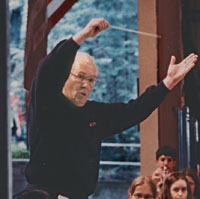 The First Holst suite has been on my all-time favorites list ever since I first heard Frederick Fennell conduct it with my band at Long Beach State. It was the concluding composition on my final concert at the University of Michigan and remains close to my heart. I have conducted the piece many, many times and look forward to doing it again in the future and whenever possible.
The First Holst suite has been on my all-time favorites list ever since I first heard Frederick Fennell conduct it with my band at Long Beach State. It was the concluding composition on my final concert at the University of Michigan and remains close to my heart. I have conducted the piece many, many times and look forward to doing it again in the future and whenever possible.
This remarkable composition is filled with numerous goodies of compositional skill, but the heart and soul of it is the reason it has captured my heart and soul for so long. The fact that it came to the band repertoire without previous original compositions of high-quality band music is a sign of Holst’s genius as a composer. With one piece he changed the destiny of band music forever and provided a model for other composers to follow when they compose original music for bands. Our entire profession will always be profoundly grateful to Gustav Holst.
H. Robert Reynolds is adjunct professor of conducting at the University of Southern California Thornton School of Music. It is a position he has held since retiring from the University of Michigan after 26 years of teaching.
John Locke
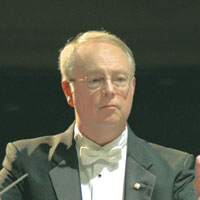 I was in the 10th grade at South Charleston High School in West Virginia playing trombone when I had my first opportunity to perform the Holst First Suite. The school year was 1967-68. My band director and mentor was A.E. Pete Raspillaire, and our high school concert band was the very best in the state. In fact, we performed at the West Virginia Music Educators Conference that year and played the Holst First Suite. I still have the recording. I owe so much to my high school band director for performing great music like the Holst, among others. He was also a trombonist and my private teacher. I believe I had heard the piece previously when my older brother performed it in the All-State band, but hearing it and paying it are completely different experiences.
I was in the 10th grade at South Charleston High School in West Virginia playing trombone when I had my first opportunity to perform the Holst First Suite. The school year was 1967-68. My band director and mentor was A.E. Pete Raspillaire, and our high school concert band was the very best in the state. In fact, we performed at the West Virginia Music Educators Conference that year and played the Holst First Suite. I still have the recording. I owe so much to my high school band director for performing great music like the Holst, among others. He was also a trombonist and my private teacher. I believe I had heard the piece previously when my older brother performed it in the All-State band, but hearing it and paying it are completely different experiences.
I can vividly remember sitting in my high school band room rehearsing the Suite and thinking that the third movement, the march, was the best music I had ever played in band. It was such a thrill. I can remember singing or whistling the tune after leaving the band room walking all the way to my father’s store where I worked after school. My father passed away in the spring of 1968, about a month before we performed at the state convention. Ironically, he was born in 1909, the same year that Holst wrote the First Suite. Some things you never forget.
Is this the greatest work ever written for band? Probably not, but it is among the most influential, especially in establishing the basic band instrumentation. I think Frederick Fennell said it best in commenting that the Holst Suite in Eb was like an old, dear friend and he could not conceive of life without it.
As I became a little older, I realized for myself what Fennell was talking about. I also realized that the only thing better than playing trombone on that piece is the opportunity to conduct it and introduce it to new generations of musicians.
John Locke is professor of music at the University of North Carolina at Greensboro where he has conducted the wind ensemble since 1982.
David Holsinger
 If there is any composition for band that I perform too much, this piece is probably the one. It is bad enough that I seem to program it at the university every seven semesters, but I can’t seem to go on the road in the spring without playing it with two or three high school bands every year. Admittedly, some of my ardor was revitalized several years ago when I asked an All-State group of 112 members how many had played the First Suite in their home bands and three hands went up – all from the same school. Shame, shame, shame!
If there is any composition for band that I perform too much, this piece is probably the one. It is bad enough that I seem to program it at the university every seven semesters, but I can’t seem to go on the road in the spring without playing it with two or three high school bands every year. Admittedly, some of my ardor was revitalized several years ago when I asked an All-State group of 112 members how many had played the First Suite in their home bands and three hands went up – all from the same school. Shame, shame, shame!
This is a magnificent piece. I love the Chaconne; it has the world’s greatest last chord. The Intermezzo is absolutely perfect in its whimsy and melodic interplay. The March is perfectly British. All young conductors who have relegated this work to the old music pile should probably reexamine their career choice. This may be the first great band work of the 20th century.
David Holsinger is a composer and director of the wind ensemble at Lee University, Cleveland, Tennessee.
Craig Kirchhoff
My experience with this great masterwork extends nearly 44 years to my high school days at John Marshall Junior-Senior High School in Milwaukee. Michael Yindra, my high school band director whose inspirational teaching and passion for music making remain an inspiration to me, introduced us to the Holst in the Spring of 1966. Our spring performance of the First Suite was later included on a record of selected performances from the school year. I haven’t listened to that recording in years, but I can distinctly remember thinking that this piece of music was very powerful and different from many of the pieces that we played that year.
As a junior flute player I certainly didn’t know what a chaconne was, had no understanding of the concept of inversion, nor was I aware of the connection of E-flat major, C minor, and C major, yet this music resonated very strongly within me. It was not until my first encounter with Frederick Fennell at a conducting symposium in the Summer of 1974 in Madison, Wisconsin that I began to comprehend the structural genius of this score and the importance of this structure as the primary unifying element of the Suite that must guide and inspire every rehearsal.
The University of Minnesota Wind Ensemble performed the Holst in October of this year to honor the 100th anniversary of its creation. I return to this work with great joy and enthusiasm every time. I never tire of its challenges, its depth, and its powerful simplicity of form and orchestra. I’m sure that if I were to revisit that 1966 John Marshall Junior-Senior High School recording, it would reveal that we didn’t capture all details. Perhaps there could have been more emphasis on the unifying suspensions and resolutions throughout the work.
Perhaps our limitations as instrumentalists resulted in the opening chaconne statement being played as two, four-measure phrases rather than one eight-measure phrase. We certainly did not play each movement without pause because that important note from Holst’s manuscript score never appeared in the early Boosey & Hawkes plates.
I have no doubt, however, that another hearing of this recording would reveal that we, indeed, captured the spirit and essence of Holst’s intentions. This defines the magic and mystery of this great masterpiece. It can inspire and motivate the high school instrumentalist, and it can inspire and challenge the artistry and the creativity of the experienced musician on many musical levels. My recent journey in October with this wonderful old friend with my colleagues in the University of Minnesota Wind Ensemble, once again, proved this to be true.
Craig Kirchhoff is director of bands and professor of conducting at the University of Minnesota.
Michael Haithcock
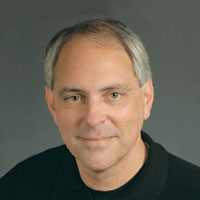 English Folk Song SuiteHolst’s First Suite remains one of my repertoire favorites as it represents both great craft and ingenious substance. The lack of continuous tutti playing throughout is in stark contrast to the expectations of the day (see Vaughan Williams ) and continues to serve as a model of effective orchestration for musical purposes as does the way the germinating three-note idea is explored fully in each movement.
English Folk Song SuiteHolst’s First Suite remains one of my repertoire favorites as it represents both great craft and ingenious substance. The lack of continuous tutti playing throughout is in stark contrast to the expectations of the day (see Vaughan Williams ) and continues to serve as a model of effective orchestration for musical purposes as does the way the germinating three-note idea is explored fully in each movement.
The proportion of tempos is extremely important to the character of the Suite. Keep the first movement moving in an English chorale style. Slow and expansive may feel romantic, but this is not a form that benefits from excessive rubato. Keep the second movement brisk and avoid the temptation to slow down for technical safety. Investigate the myth that English marches are stoic and reserved, such as the change of guards at Buckingham Palace. The last movement should be more like a folk dance than a ceremony for the Queen.
Michael Haithcock is professor of conducting and director of bands at the University of Michigan School of Music, Theatre & Dance.
Stephen Peterson
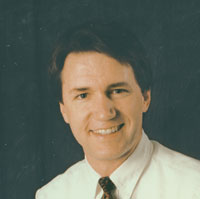 It is difficult to remember a favorite performance of this great piece. As it turns out, my favorite
It is difficult to remember a favorite performance of this great piece. As it turns out, my favorite
performance of the Holst is the one I am working on at the time. I always look forward to experiencing and sharing the Holst. Its elegance can be found in its simplicity and Holst’s masterful use of the main motive throughout.
The beauty and patience with which the Chaconne unfolds is unmatched in band literature, and stands among all music literature with no apology. There are moments of pure joy within the suite that I always look forward to, and of which I never tire. That is the mark of a masterwork.
Stephen Peterson is director of the wind ensemble at Ithaca College, Ithaca, New York.
Timothy Mahr
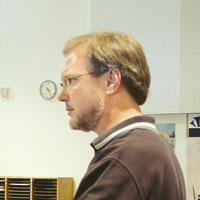 Holst’s First Suite was a favorite of my predecessor at St. Olaf College, Miles Johnson. He structured month-long study tours to the British Isles for the St. Olaf Band. In large part he believed the Holst was part of the bedrock upon which the bands of his time were built, and that we students should experience the work as thoroughly and as viscerally as possible. During the 1977 tour, he arranged to have Imogen Holst come to our rehearsal and take us through each movement, stopping often to tell us how her father liked a particular phrase shaped or a specific movement to be articulated. I remember many things from that rehearsal, but to this day I wish that we had recorded every moment of that experience.
Holst’s First Suite was a favorite of my predecessor at St. Olaf College, Miles Johnson. He structured month-long study tours to the British Isles for the St. Olaf Band. In large part he believed the Holst was part of the bedrock upon which the bands of his time were built, and that we students should experience the work as thoroughly and as viscerally as possible. During the 1977 tour, he arranged to have Imogen Holst come to our rehearsal and take us through each movement, stopping often to tell us how her father liked a particular phrase shaped or a specific movement to be articulated. I remember many things from that rehearsal, but to this day I wish that we had recorded every moment of that experience.
I marvel at how this work, so often abused and maltreated by well-intended conductors, has stood against their assault and endeared itself to many generations of performers and audience members. Truly, in the hands of top-notch performers and an unselfish conductor, the work offers a strong model to composers for expressive, economical writing and to all who hear it as music that transcends the mundane to shine a light on what the band is capable of being.
Timothy Mahr is professor music at St. Olaf College, Northfield, Minnesota, where he is conductor of the St. Olaf Band.
Robert Rumbelow
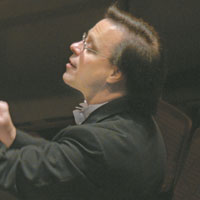 This is one of my all-time favorite band compositions because of its elegant compositional design. It is truly a work of master craftsmanship from an inspired composer. I’m attracted in a number of ways to this core work of the band repertoire on both its compositional and musical merits.
This is one of my all-time favorite band compositions because of its elegant compositional design. It is truly a work of master craftsmanship from an inspired composer. I’m attracted in a number of ways to this core work of the band repertoire on both its compositional and musical merits.
I continue to be intrigued that the work isn’t difficult in terms of technique, yet offers tremendous opportunities in mature music making. This is one of the works I use for conducting students in both analytical and gestural study. I do so in part because it never fails to amaze students (and me) how tightly integrated the entire work is from such modest tonal and rhythmic motives. The connections within the work and the perfectly paced dramatic evolution set it in a class by itself. The genius of Holst is apparent throughout, and this fact isn’t lost on performers or audiences.
Once discovered, there are many thoughtful compositional elements that dramatically influence its performance. Two of my favorites in the Chaconne deal with the drama Holst creates with rhythmic hemiola, and the orchestration realities of the last chord that links to the second movement. The two-beat feel within the 3/4 time creates musical stress in a variety of ways. It is interesting to discover and clarify the smaller moments aside from the obvious two feel at rehearsal letter D and the two groupings that delay and intensify the climax of the movement (letter F). I regard the little motive in measures 87-89 (2nd clarinet and alto sax) as an important example, and work for clear articulation. The two feel is one of the psychological reasons that trombones sometimes miss their entrance in measure 88.
Another point to share in first movement is the orchestration of the final chord with only two thirds (unfortified intentionally) in the E-flat major triad. In my mind, Holst was obviously creating an orchestration of compelling resonance based on the sonic qualities of the perfect fifth to ring in the hall between the first and second movements. Not only are the movements harmonically related, but the orchestration itself takes care of the link between the two movements. Trying to balance the 3rd in the chord robs Holst of his resonant orchestration. There are a wealth of unusually interesting details to discover, and I love sharing them with performers in the process of rehearsal and with listeners through each performance.
Robert Rumbelow is conductor and director of wind ensemble activities at Columbia State University’s Schwob School of Music, Columbus, Georgia.
Loras John Schissel
We could pay tribute to this staple of the concert band repertoire by taking out scores and studying them as if for the very first time. While I’m always delighted to see and hear this work on concert programs, I am often puzzled that it feels as though I’m listening to the old Mercury Eastman Wind Ensemble recording of it. A higher tribute to the work would be to forget everyone else’s interpretation and forge our own based on what Mr. Holst gave us. There are all sorts of delights and surprises in this classic. They are there for those who choose to look.
Loras John Schissel is the music director and conductor of the Virginia Grand Military Band and the Cleveland Orchestra’s Blossom Festival Band.
Frank Battisti
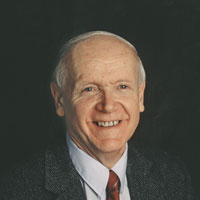 It is always a pleasure to conduct the Holst First Suite. I’ve been involved in performances of this piece for 60 years, first as a high school band player in 1949 and then as a conductor since 1959. Through a combination of a wealth of imagination and economy of notes, Holst achieves a classic balance between musical content and form in this work. The First Suite, along with the Second Suite, are the Haydn symphonies of band literature and the foundation of the great repertoire of works created for band during the 20th century and the first decade of this century. It was a special privilege to conduct the International Youth Wind Orchestra in a performance of Holst’s First Suite at the WASBE conference in Cincinnati last July during the 100th anniversary year of its composition.
It is always a pleasure to conduct the Holst First Suite. I’ve been involved in performances of this piece for 60 years, first as a high school band player in 1949 and then as a conductor since 1959. Through a combination of a wealth of imagination and economy of notes, Holst achieves a classic balance between musical content and form in this work. The First Suite, along with the Second Suite, are the Haydn symphonies of band literature and the foundation of the great repertoire of works created for band during the 20th century and the first decade of this century. It was a special privilege to conduct the International Youth Wind Orchestra in a performance of Holst’s First Suite at the WASBE conference in Cincinnati last July during the 100th anniversary year of its composition.
Frank Battisti founded and directed the wind ensemble of the New England Conservatory of Music for 30 years.
Bruce Moss
Much has been written that does not need to be reiterated about the significance of this great suite for band. Detailed analyses and papers abound, not only on the theory and structure of the work, but on how to approach the many inherent conducting issues.
What I find so appealing is the magnitude of what can be taught through this work – the sheer impact of the piece from an educational standpoint. It is a great work for the conductor as teacher. From form and analysis, to musical tone, to stylistic nuance, to ensemble blend and balance, the suite is packed with teaching material in every way. As often as it is studied and performed, it still has room for individual interpretations. It fits so many types of concert and contest programs.
Bob Reynolds programmed it on his final concert at Michigan. Frederick Fennell recorded it with the Eastman Wind Ensemble on his Mercury series. When a musical work has staying power, as this work does, it usually is a winner for many reasons. This work is a fine example.
Bruce Moss is professor of music and director of band activities at Bowling Green State University in Ohio.
A Discenting View
Mark Camphouse
I don’t consider the Holst First Suite to be great, per se. It is most definitely a cornerstone of band literature and history, but it is a rather minor work compared to his orchestral and choral music. I believe band directors will conduct the First Suite more effectively if they explore andvvvvthe symphonies and choral music of Vaughan Williams. I respect the First Suite as a fine and important work for band, but please, let’s keep it’s significance in proper perspective. In many respects, I actually prefer the Second Suite.
Mark Camphouse is interim chairman of conducting and composition at George Mason University, Fairfax, Virginia.
Have a performance tip or a favorite memory of Holst’s First Suite?
E-mail us: editor@theinstrumentalist.com
The revised edition of First Suite in E flat, edited by Colin Matthews, was published by Boosey & Hawkes in 1984.
